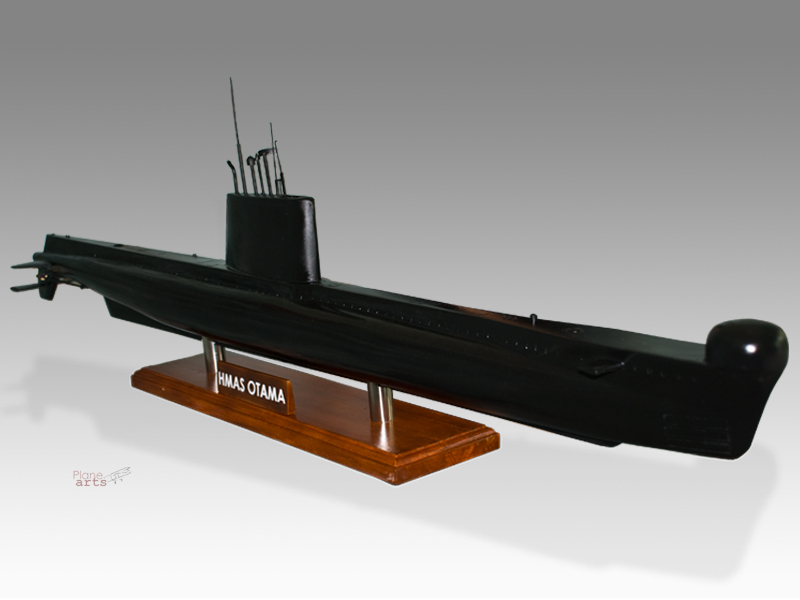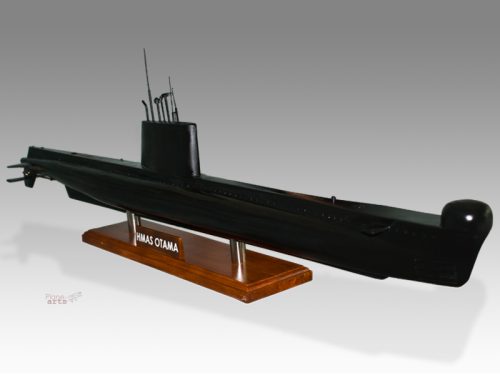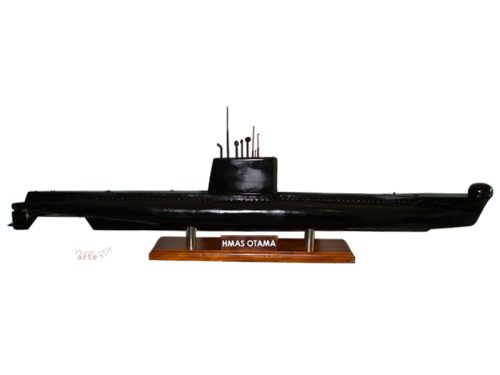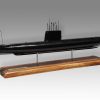HMAS Otama
Production Time 9 to 10 weeks
Shipment is by FedEx, UPS or DHL International Express Courier with a normal door-to-door delivery time worldwide of within 2-3 business days after dispatch. Due to the current volatility of world fuel prices, the amount mentioned here is our best estimate for DHL and UPS and may be subject to change at the time of shipping.

Model Description: HMAS Otama Wood Replica Scale Custom Model Aircraft
Manufacturer: Scotts Shipbuilding and Engineering Company
$239.50
Production Time 9 to 10 weeks
-
United States dollar ($)
-
Pound sterling (£)
-
Euro (€)
-
Australian dollar ($)
-
Canadian dollar ($)
-
Singapore dollar ($)
-
Swiss franc (CHF)
-
Japanese yen (¥)
-
Danish krone (kr.)
-
Hong Kong dollar ($)
-
Norwegian krone (kr)
-
Swedish krona (kr)
-
United Arab Emirates dirham (د.إ)
General Product Description
Our PlaneArts HMAS Otama replica exhibits unique, unrivaled quality and detailed design to come as close as possible to the accuracy of the actual craft. It comes as standard with a robust, durable base or stand which is available in a variety of different finishes designed to match your own personal requirements including solid wood, wood with polished metal supports or adjustable wood wall mount and will be ready within about 8-10 weeks from placement of order.
The HMAS Otama model is made of the finest kiln dried renewable mahogany wood (commonly known as Lauan or Meranti) which has undergone many stages of carving and meticulous and careful sanding giving the beautiful, finished museum quality masterpiece. Many collectors and model connoisseurs demonstrate their preference for genuine handmade and hand painted mahogany wood models rather than plastic or die cast (diecast) alternatives due to the overall look and totally different feel of the item - we trust you will find the same. We can however, if required produce the same model in Solid Cast Resin so just click and contact us for further information. Our craftsmen and gifted artisans ensure that our finely handcrafted model watercraft match the precise blueprint details of the original version. The paint scheme, markings and parts are closely matched, reflecting the original. This stylish top-quality desktop replica model will surely enthrall anyone who receives this as a gift and for sure one of the most appropriate and desirably collectable gifts for any boat, ship or similar enthusiast and avid collector whilst also displaying a perfect resemblance to the actual craft itself.
If you require, we can also make this model in any other private livery, markings or colour scheme you require and if necessary, in a different size or scale. Just click here to contact us with a description or photographs of what you require and we will let you have a quotation for the necessary customization by return email. We can also make bespoke scale replicas of any other private / civil commercial airliner or airliners, helicopter, glider, gliders with engines, military jet, warplane jets, propeller warplanes, biplane, triplane, tail fin, spacecraft, rocket or NASA model you require in any airline, military or civilian livery or colors. We also produce boat and ship collectibles. Wall plaque or seal for military, government or private customers. Again, by clicking here to contact us just let us know exactly what you need.
The HMAS Otama: Australia’s Historic Submarine
The HMAS Otama, an Oberon-class submarine, once served as a key component of the Royal Australian Navy (RAN). Built during a period marked by the Cold War, the Otama’s design and capabilities were geared towards stealth, reconnaissance, and precision in underwater operations. This article explores the technical specifications and historical context of the HMAS Otama, highlighting its role in Australia’s naval defense strategy.
Introduction to the HMAS Otama
Launched in the 1970s, the HMAS Otama was one of six Oberon-class submarines operated by the Royal Australian Navy. These submarines were designed primarily for anti-submarine warfare and intelligence gathering. The Otama was constructed by Scotts Shipbuilding and Engineering Company in Greenock, Scotland, and was commissioned into the RAN in 1978.
Key Technical Specifications:
Dimensions and Displacement:
- Length: Approximately 90 meters (295 feet)
- Beam: 8.1 meters (27 feet)
- Draught: 5.5 meters (18 feet)
- Displacement: 2,030 tons surfaced, 2,410 tons submerged
These dimensions made the Otama relatively small compared to modern nuclear submarines, but ideal for operations in the shallower waters around Australia and its environs.
Propulsion and Performance:
- Engines: Twin diesel engines for surface propulsion and twin electric motors for submerged operations
- Speed: Capable of reaching speeds of 12 knots (22 km/h) on the surface and 17 knots (31 km/h) when submerged
- Range: 9,000 nautical miles (17,000 km) at 12 knots on the surface
The propulsion system allowed for a stealthy approach and quick escape when submerged, essential for the reconnaissance and espionage roles the Otama often played.
Armament and Sensors:
- Torpedo Tubes: Six 21-inch (533 mm) tubes capable of firing Mark 48 torpedoes
- Sonar Systems: Fitted with a comprehensive suite of sonar equipment for detection, navigation, and combat
The sonar capabilities and torpedo armament were critical for the Otama’s primary role in anti-submarine warfare.
Crew and Life Onboard:
- Crew: Approximately 60 officers and sailors
- Living Conditions: Known for being cramped but efficient, with amenities typical of submarines of its era
The crew’s living conditions reflect the general operational philosophy of submarines: maximum efficiency at the expense of comfort, focusing entirely on mission accomplishment.
Historical Significance and Legacy:
The HMAS Otama served the Royal Australian Navy during a critical period in the late 20th century. Its missions often involved secretive deployments, gathering intelligence on naval activities in the Asia-Pacific region. Decommissioned in the early 2000s, the Otama’s legacy continues as it provides insights into submarine operations during the Cold War era.
Conclusion:
The HMAS Otama, with its technical sophistication and strategic deployment, played a vital role in the defense strategy of Australia. Its specifications reflect a design philosophy that balances stealth, endurance, and firepower, characteristics essential for the missions it was tasked with. As it stands today, the Otama serves as a testament to the technological capabilities and strategic foresight of the Royal Australian Navy during its time of service.
| Weight | 6 kg |
|---|---|
| Dimensions | 17 in |







Reviews
There are no reviews yet.